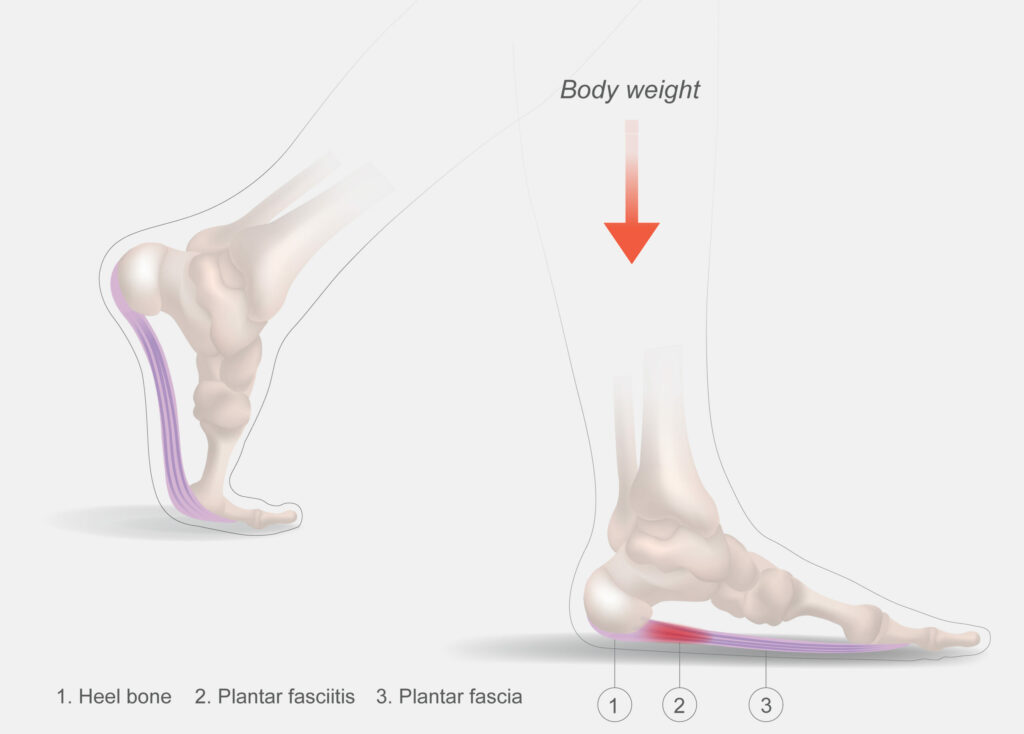Imagine waking up in the morning, setting your feet on the floor, and being greeted by a sharp pain shooting through your heel. For many people plantar fasciitis, isn’t just a hypothetical scenario – it’s a daily reality. This pain is often due to a condition known as plantar fasciitis, a common foot ailment that can significantly impact a person’s quality of life. In this blog post, we’ll delve into the world of plantar fasciitis, exploring its causes, symptoms, and the latest treatment options available right here in Sugar Land, Texas. Whether you’re a patient seeking relief, a healthcare professional looking for information, or simply a concerned friend or family member, this comprehensive guide aims to shed light on this often misunderstood condition.
Understanding Plantar Fasciitis
Plantar fasciitis refers to the inflammation of the plantar fascia, a thick band of tissue that runs along the bottom of the foot, from the heel bone to the toes. It plays a crucial role in supporting the arch of the foot. When this tissue becomes irritated or inflamed, it can lead to intense heel pain, one of the hallmark symptoms of plantar fasciitis.

The most common symptom of plantar fasciitis is a stabbing pain in the bottom of the foot near the heel. This pain is often most pronounced when taking the first steps in the morning or after a period of rest. It may gradually decrease throughout the day but can return after prolonged periods of standing or walking.
In Sugar Land, Texas, plantar fasciitis is a common issue due to several factors. The prevalence of plantar fasciitis can be attributed to the active lifestyle of many residents, which often involves activities such as running, walking, and standing for extended periods. Additionally, factors such as obesity, foot arch problems (such as flat feet or high arches), and wearing shoes with poor arch support or thin soles can contribute to the development of plantar fasciitis.
Understanding the causes and symptoms of plantar fasciitis is crucial in addressing this condition effectively. By recognizing the risk factors and seeking appropriate treatment, individuals in Sugar Land, Texas, can find relief from the pain and discomfort associated with plantar fasciitis.
Please note that the information provided is a synthesis of the content from the search results.
The Causes of Plantar Fasciitis
Plantar fasciitis can have various causes and risk factors, some of which are particularly relevant to the local population in Sugar Land, Texas. Here are the key factors to consider:
Excessive Pressure on the Plantar Fascia: The plantar fascia can become strained and inflamed due to excessive pressure. This can result from activities such as running, walking long distances, or standing on hard surfaces for extended periods. The active lifestyle in Sugar Land, Texas, which often involves these activities, can contribute to the development of plantar fasciitis.
- Foot Arch Problems: Individuals with flat feet or high arches are more prone to developing plantar fasciitis. These structural abnormalities can alter the distribution of weight and increase stress on the plantar fascia.
- Obesity: Excess weight puts additional strain on the feet and can contribute to the development of plantar fasciitis. Sugar Land, Texas, like many areas, has a diverse population, and obesity rates can vary among individuals.
- Improper Footwear: Wearing shoes with poor arch support or thin soles can fail to adequately cushion and support the feet. This can lead to increased stress on the plantar fascia and increase the risk of developing plantar fasciitis.
It’s important to note that while these factors are commonly associated with plantar fasciitis, each individual’s experience may vary. Consulting with a healthcare professional in Sugar Land, Texas, can provide personalized insights and guidance based on specific circumstances.
Diagnosing Plantar Fasciitis in Sugar Land, Texas
Diagnosing plantar fasciitis involves a comprehensive evaluation of the patient’s medical history, a physical examination, and sometimes, diagnostic imaging. In Sugar Land, Texas, facilities like Vargas Foot and Ankle Specialists are equipped to conduct this process.
The first step in diagnosing plantar fasciitis is a thorough review of the patient’s medical history. The healthcare provider will ask about the patient’s symptoms, including when they started, if the pain extends into other parts of the body, and if it’s worse during certain activities, like exercise.
Next, a physical examination is conducted. The healthcare provider will examine the foot and ankle, looking for signs of bruising, redness, or swelling. They will press on the heels and balls of the feet to check for sensitivity and test the ankles’ range of motion.
In some cases, diagnostic imaging may be required to rule out other conditions. This could include X-rays, a CT scan, or an MRI. These imaging tests can help identify fractures or soft tissue injuries that could be causing the patient’s symptoms.
Once a diagnosis of plantar fasciitis is confirmed, the healthcare provider will discuss treatment options with the patient.
Preventing Plantar Fasciitis
Preventing plantar fasciitis involves a combination of exercises, lifestyle changes, and proper footwear. By implementing these strategies, you can reduce the risk of developing this painful condition. Here are some tips to help prevent plantar fasciitis:
- Stretching Exercises: Regularly perform stretching exercises that target the calf muscles and the plantar fascia. Examples include calf stretches, Achilles tendon stretches, and plantar fascia stretches. These exercises help improve flexibility and reduce strain on the plantar fascia.
- Strengthening Exercises: Incorporate exercises that strengthen the muscles in your feet and lower legs. This can include toe curls, towel scrunches, and calf raises. Strong muscles provide better support to the plantar fascia and help prevent overuse injuries.
- Gradual Increase in Activity: If you’re starting a new exercise routine or increasing the intensity of your workouts, do so gradually. Sudden changes in activity levels can put excessive stress on the plantar fascia, increasing the risk of injury.
- Maintain a Healthy Weight: Excess weight can put additional strain on your feet and increase the risk of developing plantar fasciitis. Maintain a healthy weight through a balanced diet and regular exercise to reduce the load on your feet.
- Proper Footwear: Wear shoes that provide adequate arch support, cushioning, and shock absorption. Look for shoes with good arch support, a cushioned sole, and a proper fit. Avoid wearing worn-out or unsupportive shoes, especially during high-impact activities.
- Avoid Prolonged Standing or Walking: If your job requires long periods of standing or walking, take regular breaks to rest your feet and stretch. Consider using supportive insoles or orthotics to provide additional cushioning and support.
- Listen to Your Body: Pay attention to any signs of foot discomfort or pain. If you experience persistent heel pain or other symptoms, seek medical attention promptly to address any potential issues before they worsen.
By incorporating these preventive measures into your daily routine, you can significantly reduce the risk of developing plantar fasciitis and maintain healthy feet.
Treatment Options for Plantar Fasciitis
When it comes to treating plantar fasciitis, there are both non-surgical and surgical options available. Let’s explore these treatment options, including any innovative treatments specific to Sugar Land, Texas:
Non-Surgical Treatments:
- Physical Therapy: Physical therapy can help strengthen the muscles and improve flexibility, reducing strain on the plantar fascia. Therapists may use techniques such as stretching exercises, massage, and ultrasound therapy.
- Orthotic Devices: Custom orthotic inserts or shoe inserts can provide additional support and cushioning to the foot, relieving pressure on the plantar fascia.
- Night Splints: Wearing a night splint keeps the foot in a stretched position while sleeping, promoting healing and reducing morning pain.
- MLS Laser Therapy: MLS (Multiwave Locked System) Laser Therapy is a non-invasive treatment that uses specific wavelengths of light to reduce pain and inflammation while promoting tissue repair. It can be effective in managing plantar fasciitis symptoms. Learn more https://thefootpros.com/mls-laser/
- EPAT (Extracorporeal Pulse Activation Technology) Shockwave Therapy: EPAT shockwave therapy delivers acoustic pressure waves to the affected area, stimulating metabolism and enhancing the healing process. It has been found to be beneficial in treating plantar fasciitis. Learn more https://thefootpros.com/epat-therapy/
- Biologic Therapy: Biologic therapy, such as amnio biologic therapy, utilizes natural growth factors to promote healing and reduce inflammation in the plantar fascia. Learn more https://thefootpros.com/biologic-therapy/
Surgical Treatments:
- Plantar Fascia Release: In severe cases where non-surgical treatments have not provided relief, a surgical procedure called plantar fascia release may be considered. This involves partially cutting the plantar fascia to relieve tension and reduce pain.
- Gastrocnemius Recession: If tight calf muscles contribute to plantar fasciitis, a gastrocnemius recession surgery may be performed. This procedure lengthens the calf muscle, reducing strain on the plantar fascia.
In Sugar Land, Texas, healthcare providers like Vargas Foot and Ankle Specialists offer a range of treatment options for plantar fasciitis, including innovative approaches like biologic therapy, MLS Laser Therapy and Extracorporeal Pulse Activation Technology.
It’s important to consult with a healthcare professional to determine the most suitable treatment plan based on individual circumstances.
Conclusion
In conclusion, plantar fasciitis is a common condition characterized by inflammation and pain in the plantar fascia, a thick band of tissue in the foot. Key takeaways from this blog post include:
- Plantar fasciitis can cause significant heel pain and impact daily activities.
- Common causes of plantar fasciitis include excessive pressure on the foot, foot arch problems, obesity, and improper footwear.
- Symptoms of plantar fasciitis include stabbing pain in the heel, especially in the morning or after periods of rest.
- Diagnosing plantar fasciitis involves a thorough medical history review, physical examination, and sometimes, diagnostic imaging.
- Prevention strategies include stretching and strengthening exercises, gradual increase in activity, maintaining a healthy weight, and wearing proper footwear.
- Non-surgical treatments for plantar fasciitis include physical therapy, orthotic devices, night splints, extracorporeal shockwave therapy (ESWT), and biologic therapy.
- In severe cases, surgical options such as plantar fascia release or gastrocnemius recession may be considered.
- Seeking treatment for plantar fasciitis is crucial to alleviate pain, improve mobility, and prevent the condition from worsening.

It is important to emphasize the significance of seeking treatment for plantar fasciitis. Early intervention and appropriate management can lead to better outcomes and a faster recovery. If you are experiencing symptoms of plantar fasciitis, consult with a healthcare professional, such as Vargas Foot and Ankle Specialists in Sugar Land, Texas, to receive a proper diagnosis and personalized treatment plan.
Remember, taking proactive steps towards treatment can help you regain comfort and mobility in your daily life.
If you or someone you know is experiencing symptoms of plantar fasciitis, don’t wait to seek help. Early diagnosis and treatment can significantly improve the outcome and speed up recovery. In Sugar Land, Texas, Vargas Foot and Ankle Specialists are ready to assist you.
Don’t let foot pain hold you back from enjoying your daily activities. Schedule an appointment with Vargas Foot and Ankle Specialists today and take the first step towards relief.
Lastly, if you found this blog post helpful, please share it with others who might benefit from this information. Together, we can spread awareness about plantar fasciitis and the importance of seeking timely treatment.
Sources
- Plantar Fasciitis: A Concise Review’ from the National Center for Biotechnology Information
- Plantar Fasciitis and Bone Spurs‘ from the American Academy of Orthopaedic Surgeons
- Plantar Fasciitis‘ from the Mayo Clinic
















